Will electric cars save our planet? No. How about wind turbines? Better home insulation? Smokestack scrubbers? All of the above? It’s going to take a lot to win our race against climate change, but conservation, mitigation, and transition to green energy will only get us to the halfway mark.
What more do we need? The answer has been hidden for decades in reports issued since 1990 by the UN’s Intergovernmental Panel on Climate Change (IPCC). In what has been a whopper of a missing ingredient so far in the global fight to save our planet, all the IPCC’s 200-plus projections describing how warm our planet will get assume that humans will somehow start physically removing huge amounts of carbon dioxide (CO2) from the Earth’s atmosphere by around 2030. That’s Huge amounts with a capital H, as in over a thousand times what we’re removing today, starting about seven years from now and continuing until around the year 2100. Without removing between 450 billion and 1.1 trillion tons of CO2 from the atmosphere over this period (about 10 billion tons per year starting in 2030 and increasing to about 25 billion tons annually by 2070—see below chart), the average temperature on our planet by the end of this century will blow past “manageable” and careen well into dangerous territory.
 Why is this news? For one, the IPCC has been hoping for years that humans will be able to keep the global average temperature increase to under 1.5 to 2 degrees Celsius (or 2.7 to 3.5 degrees Fahrenheit, basically increasing the global average temperature from 59 degrees F to between 61.7 and 62.5 degrees F). In its latest report, though, the IPCC concedes we’re very likely to go well past these low targets and are now looking at a global temperature rise of somewhere between 2.7 and 3.5 degrees C (or 4.9 to 6.3 degrees F, meaning an increase in the global average temperature from 59 F to between 63.9 F and 65.3 F). And this assumes we’ll meet the next set of emissions targets, even though we just badly missed the last set.
Why is this news? For one, the IPCC has been hoping for years that humans will be able to keep the global average temperature increase to under 1.5 to 2 degrees Celsius (or 2.7 to 3.5 degrees Fahrenheit, basically increasing the global average temperature from 59 degrees F to between 61.7 and 62.5 degrees F). In its latest report, though, the IPCC concedes we’re very likely to go well past these low targets and are now looking at a global temperature rise of somewhere between 2.7 and 3.5 degrees C (or 4.9 to 6.3 degrees F, meaning an increase in the global average temperature from 59 F to between 63.9 F and 65.3 F). And this assumes we’ll meet the next set of emissions targets, even though we just badly missed the last set.
To state the obvious, the more targets we miss, the hotter it will get, and the steeper our future cuts will need to be. In addition, the more targets we miss, the more urgent our need may become to figure out how to remove CO2 from our atmosphere in order to keep our planet from boiling over. It isn’t as though this need has been kept a secret—it’s been spelled out in every IPCC climate report and has figured prominently in the last few reports. But for whatever reason—maybe because these reports are so badly written, or because climate change has been scoffed at by too many US politicians for too long, or because the policy world has so much momentum invested in cutting emissions—we have yet to focus on this issue.
It also hasn’t helped that the idea of removing greenhouse gas emissions from our atmosphere is a political hot potato, even among IPCC panelists and the environmental community, who argue (for whatever reason) that by focusing on CO2 removal we’re giving ourselves license to keep polluting. The funding has also been lackluster, with Bloomberg estimating we spent only $6.4 billion globally in 2023 on carbon capture and storage removal (compared with $750 billion for all energy transition investments in 2021). Most of this spending has been concentrated in just a few parts of the world as well (mostly the US). While a few private companies have been capturing CO2 from the atmosphere for over a decade already, these efforts have been the equivalent of a climate change side show, far from mainstream funding or policy conversations.
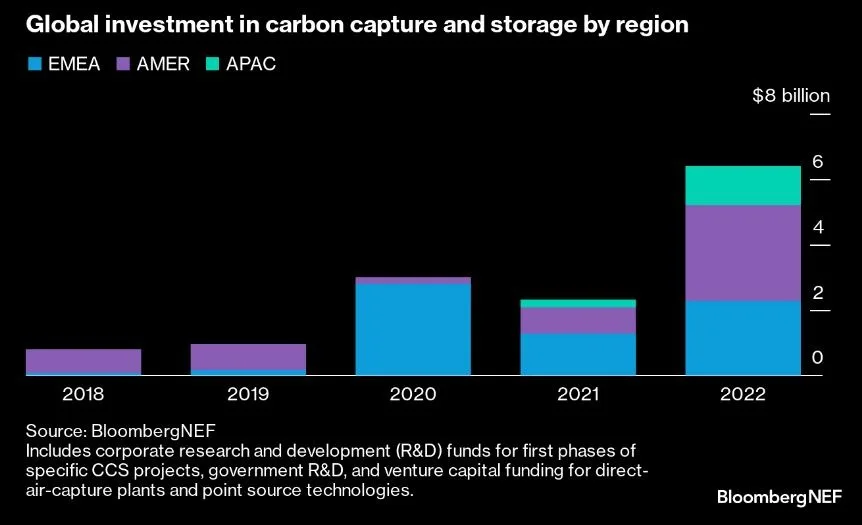
The truth is, we need to do both, and soon: We need to continue focusing on emissions reductions and transitioning to green energy, but at the same time we need to massively ramp up our attention to and investments in greenhouse gas mitigation and capture efforts, just as the IPCC has been recommending all along. This isn’t new advice, and yet somehow it is.
An independent group of climate experts made this case rather forcefully in a report they issued in early 2023 titled “The State of Carbon Dioxide Removal” (see the additional reading list at the end of this article). Below, the top chart from this report shows how the time period between now and mid-century will be dominated by emissions-reductions efforts, and from mid-century on by CO2-removal efforts; the bottom two charts show how much of this CO2 removal will need to happen through conventional and novel means. Conventional means are mostly grasslands and forest-related (managing forests, reforestation, and planting new trees where there are none currently). So-called novel means are many and varied and can be used to both reduce CO2 emissions from point sources like smokestacks, and also pull CO2 out of the air and store it safely for long periods of time. Processes that can actually remove carbon dioxide from the atmosphere and store it durably for at least hundreds of years are called Carbon Dioxide Removal (CDR) solutions. Novel CDR solutions include bioenergy with carbon capture and storage (BECCS), biochar, direct air carbon capture and storage (DACCS), enhanced rock weathering, coastal wetland management, soil carbon sequestration (various ways of managing land, especially farmland, so that soils absorb and hold more carbon), and even more controversial ideas like ocean fertilization and alkalization.
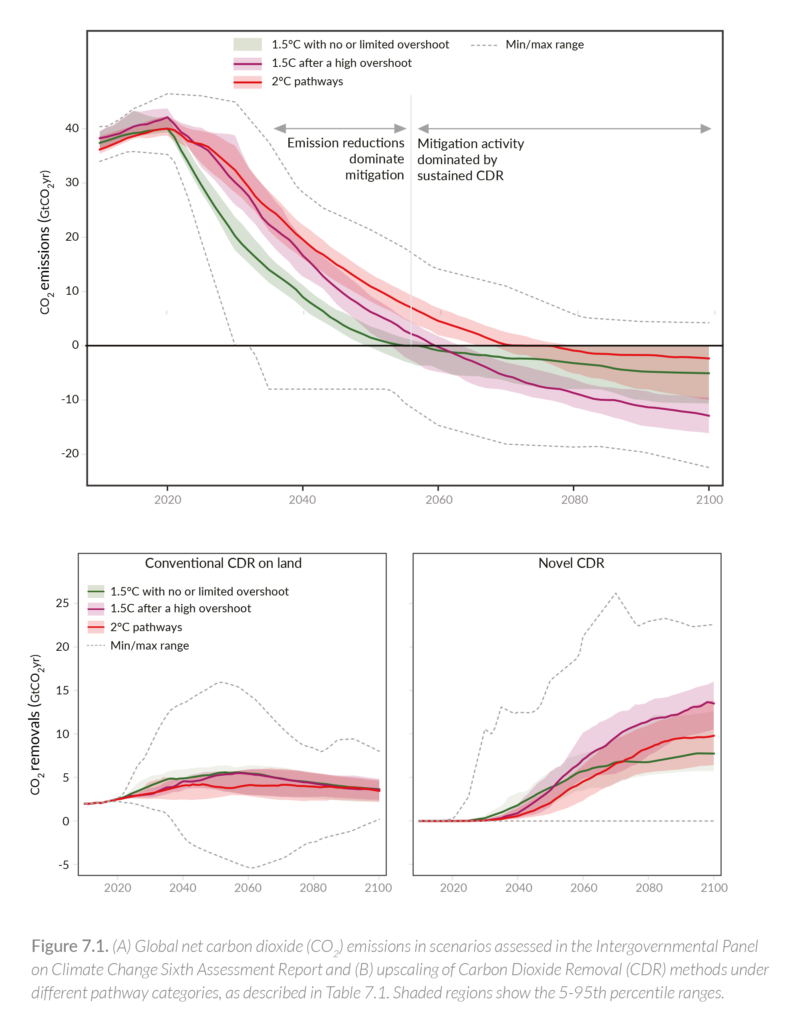
These processes all differ in terms of their costs, practicality, effectiveness, scalability, technological readiness, and undesirable impacts (like energy consumption). But we don’t really know a lot more than this—certainly not enough to begin large-scale deployment of any single solution tomorrow. For instance, dumping finely crushed carbonate rocks (like olivine—found in abundance on the surface in Washington, Oregon, and California) into the ocean might soak up massive amounts of CO2 and also stabilize the ocean’s increasing alkalinity. Olivine on land can also be injected with hot water, which encourages it to absorb more CO2 from the air. This approach has the highest potential of all novel methods, possibly able to remove 100 billion tons of CO2 per year from our atmosphere. But it has never been tested at scale. What are the risks and downsides? How much mining and crushing are we talking about and how quickly can this solution be tested and implemented? Similarly, direct air capture solutions (DACCS) require energy to run, chemicals to capture CO2, and presume that long-term underground storage is possible, but this too has never been tested at the scales needed to make an impact. The potential is there to capture up to 40 billion tons per year, but we just don’t know enough yet. There are many other options as well, all with their attendant costs, mitigation potential, risks, and states of readiness.
For certain, all these solutions have the potential to help in the fight against climate change. And we’ll benefit from adopting solutions that pull greenhouses gases from our atmosphere as well as solutions like smokestack screens that capture CO2 before it ends up in our atmosphere. But it’s this first approach—CDR solutions that pull out CO2—that the IPCC is referring to when it says we need to create lots of CO2 removal capabilities in the very near future.
To date, most of our activist, political, and policy attention has been focused not on these novel solutions but on conventional solutions—trees and grasslands. Both are excellent CO2 vacuums. Mature grasslands can absorb about 50 tons of carbon dioxide per acre per year, plus they store this carbon in the soil instead of in wood that can burn. Mature trees, on the other hand, can absorb about 50 pounds of CO2 from the atmosphere every year, which pencils out to around 40 mature trees per ton of CO2 removed. At 700 trees per acre, that’s 17.5 tons of CO2 sequestration per acre per year—only one third of what grasslands can absorb but still a good number. Like grasslands, trees can also store CO2 for a reasonably long time (unless they burn), and even though they will blow carbon back into the atmosphere when they do burn, they can also recover more quickly than grasslands (which can take a century or longer to grow back) and are cheap and easy socially, technically, and politically. Trees also provide palpable spin-off benefits—shade, building products, habitats, and so on, and they’ve been the center of lots of political attention over the past several decades.
So, the idea of using trees to save our planet has a big fan base, to the point where planting more trees has probably been the most hyped climate change policy of all. Unfortunately, relying on trees alone is a wildly impractical idea. We would need to cover an area more than twice the size of North America with somewhere around a trillion new trees (i.e., removing 20 billion tons annually by 2070 at 40 trees per ton means planting about 800 billion trees; and although estimates vary, this many trees would require around 10 trillion acres of space), a task that by some estimates would require many generations to complete, even if we had the land, seedlings, money, and political will to complete it (indeed, a trillion tree effort has already been underway globally for more than 20 years and it isn’t making an impact on climate change). So, forests can be a small part of the overall solution, but they certainly can’t be the only solution we pursue, and our tree-planting enthusiasm shouldn’t cast shade on the real CO2 removal policies we need to develop with haste.
In the meantime, CO2 continues to blast into our atmosphere. Most of this happens through natural processes like outgassing from the ocean, decomposition, volcanoes, and even belching animals—about 100 billion tons annually. Human activities like burning fossil fuels, however, add another 37 billion tons to this total every year. While the Earth’s natural sponges like forests, grasslands and oceans have been excellent at soaking up CO2 over our history (a process known as the carbon cycle; see graphic below), the extra human contribution (so-called anthropogenic carbon dioxide) is proving to be more than our planet can handle. Today, only about two billion of this extra 37 billion tons of CO2 we add to the Earth’s atmosphere every year is being absorbed or captured. And of these two billion tons, only 0.1% is being captured through CDR. As a result, the concentration of CO2 in our atmosphere is now higher than ever before in our planet’s history.
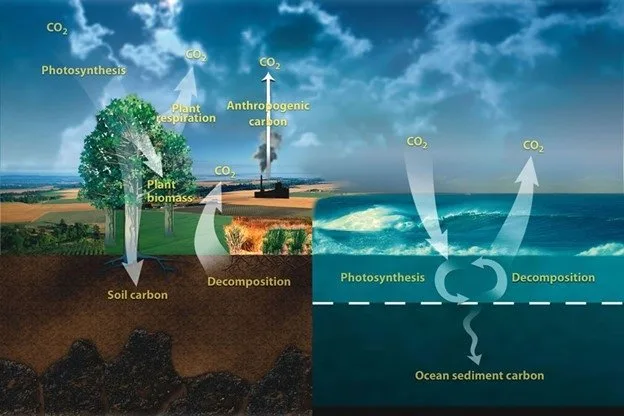
Fortunately, we haven’t put all our chips on trees. Our focus on reducing emissions and developing green energy alternatives has been making a limited impact in different parts of the world, but the challenges that confront policymakers are more often political than technical. In the US, Republicans have become the party of anti-truth, convinced that climate change (and many other truths) are a hoax, so passing any aggressive climate change legislation that will hurt oil producers or coal miners is a non-starter. And on the international stage, the world’s largest economies can’t just call a time-out, but need to work together to find suitable pathways to lower their prodigious outputs of CO2 without also lowering their GDPs. China currently accounts for about 31% of all CO2 emissions, followed by the US at 13.5%, India at 7.3%, Russia at 4.7%, and Japan at 2.9 percent (although historically, the US has been by far the largest contributor to greenhouse gases).
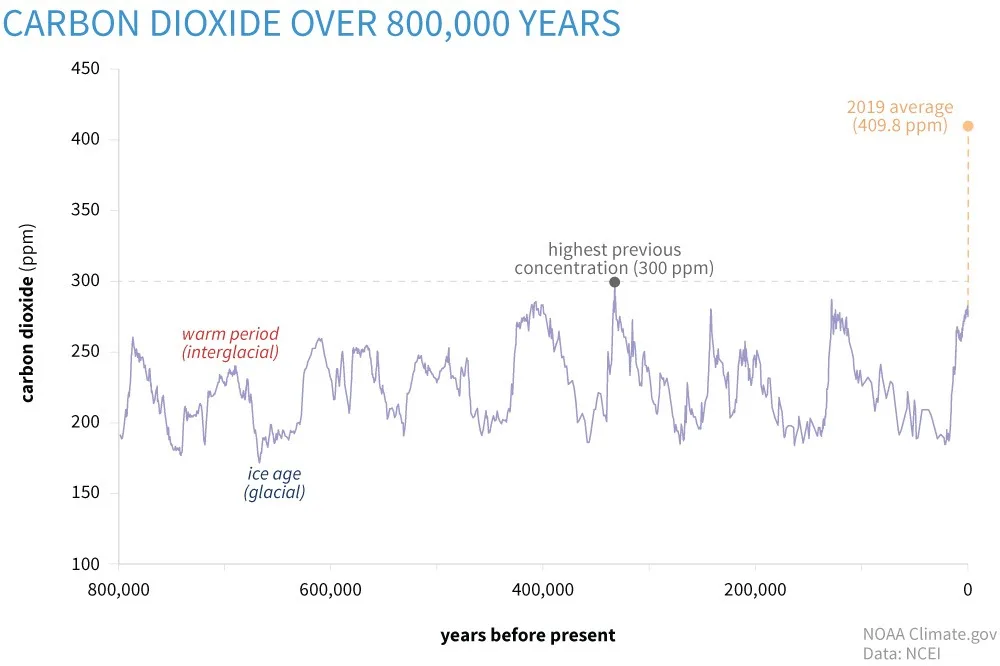
CO2 is also coming from many different sources so we can’t just think in terms of converting to electric cars. In the US, slightly more CO2 pollution comes from our transportation systems than from any other source, and of this amount, our personal vehicles account for more than half (58%) of all our transportation-related CO2 emissions. Therefore, working to curb US auto emissions makes perfect sense because our 300 million cars create around a billion tons of CO2 annually, or about 17% of the roughly 6.3 billion tons of CO2 the US puts into the atmosphere every year.
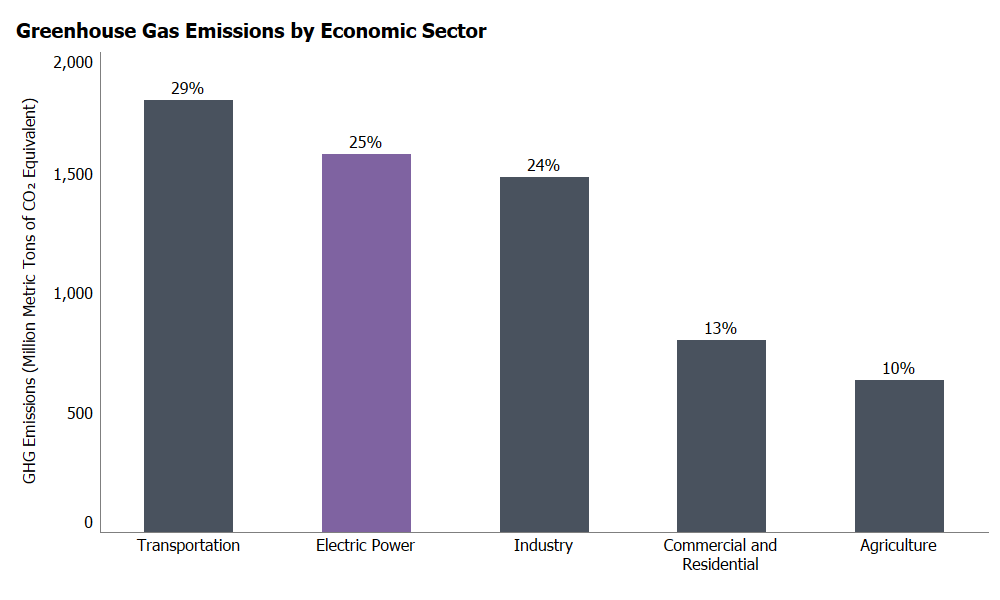
Globally, however, heat and power industries account for a little under half of all anthropogenic CO2 emissions, followed by transportation (about 25%), processing industries like oil and cement (about 20%), and residential and commercial emissions (about 10%). This is particularly visible in China and India, where around two-thirds of their total CO2 emissions are coming from coal-fired power plants. Focusing on replacing these plants or at least fitting them with CO2 scrubbers might be the best approach for these countries.
Still, even if every gas guzzling car in the US gets replaced by a Tesla tomorrow, and every power plant in China becomes hydroelectric, global temperatures will still keep rising. Like it or not—whatever our philosophical or political objections—we also need to focus without delay and with great international resolve on removing the accumulated and accumulating CO2 in our atmosphere, starting by working together to decide which methods are the most realistic to refine and deploy at scale over the next decade. At the moment, though, policy makers, politicians and the public know very little about any of this. We are not focused on CDR in the slightest, and we need to be.
What if we don’t, though? What happens if we don’t do any novel CDR? Well, who doesn’t like warmer temperatures, right? Or so goes one argument—that the benefits of climate change will outweigh the negatives. Keep in mind that when scientists predict a large increase in the global average temperature, this number averages the temperatures at the poles with the temperatures at the equator. Many parts of our planet near the equator are already dealing with heat that makes human life difficult. Adding another 6.3 degrees F or more (now a likely outcome) could very well make many regions of our planet uninhabitable.
Temperature increases this extreme also have a high probability of triggering failures in both natural and social systems, meaning that the warmer it gets, the more systems will fail and make conditions even worse. Among these failures are:
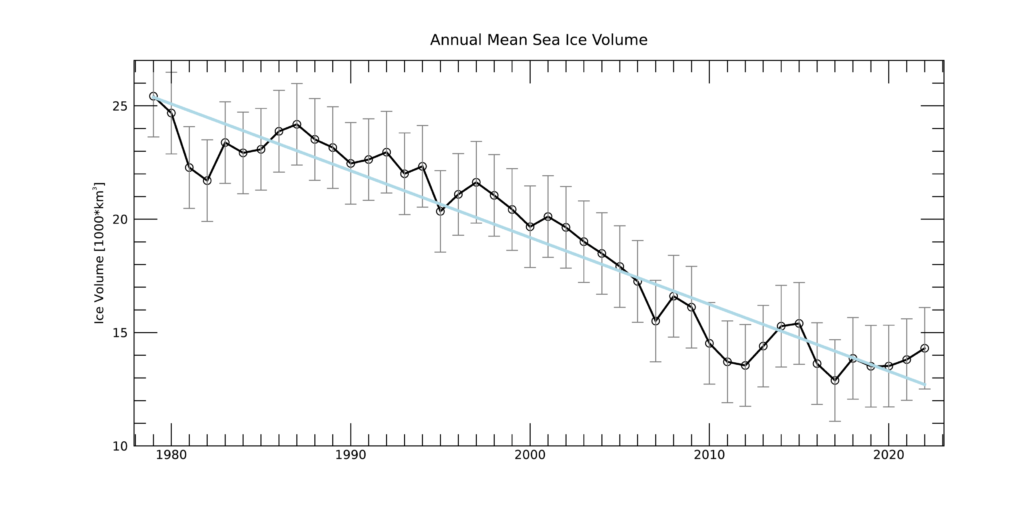
As if all this isn’t enough, temperature rises of this magnitude might even lead to other catastrophic changes we simply can’t predict. Some astronomers believe, for example, that climate change on Venus eons ago led to a “runaway greenhouse effect,” transforming the planet from a lush green twin of Earth into the barren CO2-shrouded hellscape it is today with average surface temperatures of over 800F. We aren’t close to having this situation happen yet on Earth, but the warmer our planet gets, the more unpredictable climate change becomes.
Believe it or not, though, there’s even more bad news. What happens when we bring methane into the equation? Earlier in this essay, it was noted that as global temperatures rise, massive amounts of methane will start belching into our atmosphere from the long-frozen permafrost regions of our planet. These are large tracts of land covering about 11% of the surface area of our planet that have been permanently frozen for thousands of years. Mixed in with icy rock and dirt are about 1.5 trillion tons of carbon in the form of decaying plant life—more than twice the amount of carbon currently stored in our atmosphere—as well as 60 billion tons of methane (compared with our atmosphere’s current methane content of 600 million tons). And these totals don’t even include subsea permafrost regions which are already starting to percolate.
Why worry? After all, methane is only a distant second in terms of the most abundant greenhouse gases in our atmosphere (CO2 accounts for about three-quarters of all greenhouse gases, followed by methane at about 16 percent). Unfortunately, even though it is less abundant than CO2, methane has 34 times more Global Warming Potential (GWP) than CO2 on a century timescale, and 86 times more on a 20-year timescale. Which is to say that methane may not stick around for as long as CO2, but it is a much more powerful greenhouse gas over its short lifespan, likely responsible for around 30% of the rise in global temperatures since the Industrial Revolution started around 1750—since we started making things more with machines than by hand.
And global methane emissions are rising fast, now totaling around 600 million tons per year, with cattle farming, rice farming, and waste management combining to account for about 60% of this total, and the energy industry adding most of the rest.
This is a good news bad news situation. The good news is that cutting methane emissions is one of the most effective ways to limit global warming and improve air quality in the near term. It’s also relatively easy to go after the low-hanging fruit. Methane emissions from oil and gas alone—which account for about 40% of all the methane released into the atmosphere each year—could be reduced by 75% by stopping all non-emergency flaring and venting of methane and capturing this methane for reuse instead (using tried and tested policies and technologies). In fact, the captured methane would amount to more than the European Union’s total annual gas imports from Russia prior to the invasion of Ukraine—a win-win in terms of a fix that more than pays for itself.
With our current technology, point source controls like this are more practical for methane than removing it directly from our atmosphere like CO2. For one, methane is about 200 times less abundant in our atmosphere than CO2 so more air would need to be sucked in per unit of methane captured (which means using more energy for this operation). And two, methane is also harder to remove, technically speaking—it isn’t as susceptible to being captured. Therefore, our removal efforts will be better focused on mitigating methane at point sources like oil or natural gas fields, landfills and agricultural sites. A dairy farm, for example, can have methane concentrations 1000 times the average atmospheric concentration.
The return on investment for even modest efforts like this is significant. A 40% reduction in methane emissions by 2050 could cause a temperature drop of around 0.3 C, which is huge considering that if we can keep the temperature increase to around 2 C, we are less likely to see the catastrophic effects from cascading temperatures. Plus, we can get close to this 40% reduction by just capping oil and gas wells.
So why don’t we already? That’s the bad news. The global policy environment for methane reduction isn’t as robust as for carbon dioxide reduction. There is a global policy framework in place—to-date, 125 countries have signed a Global Methane Pledge—but as with our carbon dioxide efforts, the results are falling far short of what is needed. Different countries are trying to make a difference as well. In the US, the Biden Administration unveiled its Methane Emissions Reduction Action Plan in 2021 to tackle methane emissions and support a clean energy economy, including providing money for cleaning up orphaned oil and gas wells, and researching efforts and investments to reduce methane emissions from beef and dairy farms.
Imposing modest fees might be another route to controlling methane. Some analysts estimate that a global methane fee of around $70 per ton would be enough to drive down emissions to the levels consistent with keeping global warming below 2 degrees C, although again, that ship has sailed. At this point, according to the IPCC, we’re now talking about policies that will hopefully keep the Earth from warming no more than 3.5 C, which is significantly warmer than 2 C but maybe not unrecoverable if we start focusing more on removing greenhouse gases from our atmosphere.
Climate change can be a tough idea to grasp, and an even tougher idea to sell. As a result, it’s been easy to oversimplify things—-to soft sell the idea that simply switching to electric cars and wind power, for example, will save our planet. This easy sell approach isn’t going to be enough, though. By the IPCC’s own data, we’re also going to need to invest massively more than we do today to remove greenhouse gasses in huge quantities from our atmosphere over the next 75 years. And so far, we’ve mostly avoided talking about this need, or we’ve labeled it as something that will take our focus away from the real challenge of cutting emissions.
In fact, though, a global effort to remove greenhouse gases from our atmosphere is vitally important to the future of our climate change efforts. Indeed, this may well be the defining challenge for modern human society, far too essential to simply ignore, and at the same time far too vast and expensive to be carried out by any single country working alone. If we succeed, we’ll save our planet. If we don’t succeed, the coming century will reshape the entire human experience.
Additional reading:
Top of page photo from Climeworks
Glenn is Executive Director of the Science Communication Institute and Program Director for SCI’s global Open Scholarship Initiative. You can reach him at [email protected].

